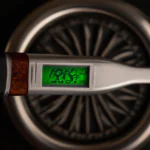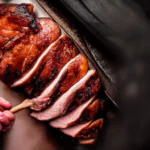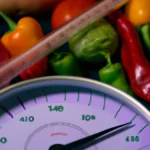Turkey is the star of the show during Thanksgiving dinner, and cooking it to perfection is key. Making a perfectly roasted Thanksgiving Turkey is not only about the taste, but also about cooking it through to the right level of doneness. To make sure that your turkey is cooked safely and evenly, it is important to use a thermometer. But do you know where to place it? In this article, we’ll give you a step by step guide for the proper placement of the thermometer for cooking turkey, as well as other tips on roasting the perfect turkey.
Table of Contents
Where to put the thermometer in turkey
A thermometer is an essential tool for every chef to make sure that the turkey is cooked to perfection. Here’s a simple guide on where to insert the thermometer when preparing a whole turkey:
- The breast is the thickest part of the turkey, so the thermometer should be inserted into the innermost portion of it. Take care not to touch the bone, gristle or the pan.
- The thigh is another part of the bird where you can insert the thermometer. Make sure to probe deep into the innermost section of this muscle group.
- The wing should not be neglected – don’t forget to measure its temperature too! Place the thermometer exactly where you did with the breast and thigh: in its innermost portion.
How to ensure a successful measurement
Make sure all your measurements are consistent, that means keep track of temperature readings for each part you probe. To check if your turkey is cooked and safe to consume, use these recommended internal temperatures:
- White meat: 165˚F
- Dark meat: 175˚F
Remember: ensure that your thermometer does not touch bone, gristle or the pan while you’re probing each part of your turkey. With these tips, you’ll be able to measure with accuracy and cook a delicious dinner! Bon appétit!

Don’t Overcook It: How Far to Insert a Meat Thermometer in Your Turkey
Are you looking for the proper way to take a temperature of your turkey and know when it’s cooked through? The key to success is using a meat thermometer! Following these guidelines will help ensure your bird is cooked safely and to the proper temperature.
The tip of the thermometer should be inserted into the thickest part of the thigh, avoiding any contact with bone. Take frequent readings while cooking, as this will help track progress and make sure nothing is overcooked. Be sure to also check the temperature of stuffing, when applicable. It’s necessary for stuffing to reach 165°F.
Once your turkey reaches an internal temperature of 180°F in its thigh and 170°F in its breast, it is ready to safely come out of the oven. But don’t just rely on the thermometer readings. Observe the bird visually, ensuring it appears cooked and golden brown on the outside.
- Insert thermometer tip into thick thigh without touching bone.
- Check internal temperature in thigh (180°F).
- Check internal temperature in breast (170°F).
- Stuffing must reach 165°F.
Using a meat thermometer correctly is essential for food safety and making sure your turkey comes out nicely cooked and delicious. Use these tips each time you cook your turkey, and you’ll never have to worry about anyone getting ill!
Searching for the Sweet Spot: How Far to Insert a Meat Thermometer
Accurately measuring the temperature of the meat is essential for cooking it right. Using a food thermometer to check the internal temperature of meat and poultry is one of the surest ways to be sure of its safety and doneness. But, how far should you insert the thermometer probe into the meat? Keep reading to find out.
Both digital and analog thermometers come with probes that need to be inserted into the food being measured. The depth of insertion depends largely on the type of thermometer and should be carefully monitored to make sure that an accurate reading is taken. For instance, most thermometers require you to insert the probe at least 1/2 inch into the meat, although for specific models such as Thermoworks, only 1/8 inch is required.
In general, if the food being cooked or grilled is thicker than an inch then it’s advised you go deeper than that recommended minimum to reach its center. To ensure an accurate result it’s important you insert the probe in a straight line while pushing until it completely disappears into the thickest part.
To summarise:
- Most digital and analog thermometers require at least 1/2 inch insertion in meats.
- Thermoworks models need only 1/8 inch insertion.
- If meat is thicker than an inch, deep insertion may be necessary.
- For accurate results insert the probe in a straight line in thickest part.
Leaving it In or Taking it Out: The Thermometer’s Role in Cooking a Turkey
Cooking the perfect turkey is a labor of love, and one of the most important things to remember when preparing your bird is to check the temperature with an oven-safe meat thermometer. This type of thermometer can be used regardless of the size or cut of meat you’re cooking, which makes it even more useful for holiday dinners – particularly since large birds like turkeys can take longer than expected to cook through.
So to answer your question directly, yes, you can leave the thermometer in while roasting your turkey or grilling any other type of meat. Doing this helps ensure that all of the parts of your bird, including those deep inside, reach a safe temperature during the cooking process. As long as your thermometer is oven-safe, it can withstand the heat from the oven or grill while still accurately gauging whether or not your turkey is done.
Here are some tips for using an oven-safe meat thermometer in your cooking:
- Always place the thermometer into thickest part of the cut. This ensures that it reads the proper temperature and doesn’t get left out of certain areas.
- Check it frequently. Set an alarm on your phone or keep a regular watch on the oven window so that you don’t let it cook too long (or not long enough!).
- Always wait 5 minutes before removing from heat source. Allow time for the thermometer to cool down and give you a proper reading.
- Make sure not to touch any hot surfaces in your oven when checking temperatures.
By using an oven-safe meat thermometer and following these simple guidelines while cooking your turkey, you can make sure to always enjoy a perfectly cooked bird! And since oven-safe meat thermometers can be used with almost any type of roast or poultry, they make great tools for grilling and roasting other meats as well.
The Juiciest Bird Yet: Do You Put Water in the Bottom of the Roasting Pan for a Turkey?
No, we do not recommend adding water to the bottom of the pan when cooking a turkey. While steaming your turkey is an acceptable method, it is not the preferred way to cook a turkey.
The ideal method to prepare a delicious turkey is by roasting it in the oven. When roasting, there are several approaches you can take, which all yield equally delicious results.
The best ways to roast a turkey
Roasting your turkey without water will produce the most juicy and flavorful result:
- The first approach is to simply place it in the roasting pan without adding anything else. Add seasonings such as pepper and salt and other spices as desired. You can also stuff your turkey with herbs or vegetables for added flavor.
- The second approach is to rub butter or vegetable oil all over the skin of the bird prior to placing it in the pan. This will help keep it moist and add flavor to the skin.
- The third approach is to add some liquid, such as broth or white wine, to the bottom of the pan. This will provide some moisture while cooking and add flavor as well. However, avoid adding too much liquid as this could lead to an overcooked turkey.
Other tips for cooking a delicious holiday turkey
Always ensure that you cook your turkey until it reaches an internal temperature of 165°F before serving:
- Be sure to use a cooking thermometer to check if your turkey is done properly.
- Be sure to cover your roasting pan with aluminum foil when baking, so that the juices remain in the pan while it cooks.
- Let your cooked bird sit for at least 15 minutes before carving, so that all of its juices are locked in while at rest. This helps achieve optimal juiciness!




